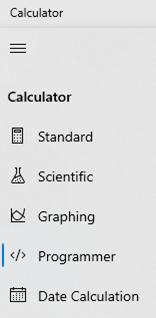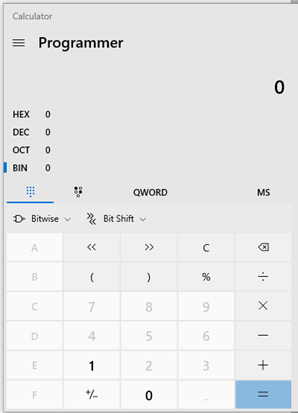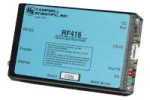This product is not available for new orders.

| Services Available | |
|---|---|
| Repair | No |
| Calibration | No |
| Free Support | No |
Overview
The RF401 has a 910 to 918 MHz operating frequency range, which is used in the US and Canada. This 100 mW spread-spectrum radio can transmit data to another RF401 radio, an RF430 radio, a CR206(X) datalogger, or an AVW206 vibrating-wire interface.
The RF401 supports point-to-point and point-to-multipoint communications. It can serve as a field modem/radio while connected to the datalogger or as a base station modem/radio while connected to a computer. The radio can also serve as a stand-alone RF router/repeater.
Read MoreBenefits and Features
- Rugged, low-cost transceivers
- Can be used in the field as a transceiver or in the office as the base station
- Individual FCC license not required
- Transmits up to one mile with omnidirectional antenna; up to 10 miles with higher gain directional antennas at ideal conditions
- Settings stored in non-volatile memory
- Frequency-hops over 25 channels avoids interference from other spread spectrum radios
- Optional extended temperature testing
- Faster communication due to elimination of some small "link state packets"
- Ability to have stand-alone RF router/repeaters (up to 8 repeaters)
- Greater immunity to interference and RF collisions by using RF retries
- Reduced power consumption by the data logger, as the radios perform "packet address filtering"
- Designed for use in PakBus networks
- Built-in setup menus allow access to advanced functionality
Images









Similar Products
Detailed Description
The RF401 reduces susceptibility to RF interference from other spread spectrum devices by providing user-selectable frequency hopping patterns. Spread spectrum radios spread the normally narrowband information signal over a relatively wide band of frequencies. This process allows communications to be more immune to noise and interference from RF sources such as pagers and cellular phones.
Compatibility
Please note: The following shows notable compatibility information. It is not a comprehensive list of all compatible products.
Dataloggers
| Product | Compatible | Note |
|---|---|---|
| 21X (retired) | ||
| CR10 (retired) | ||
| CR1000 (retired) | ||
| CR1000X (retired) | ||
| CR10X (retired) | ||
| CR200X (retired) | ||
| CR206X (retired) | ||
| CR211X (retired) | ||
| CR216X (retired) | ||
| CR23X (retired) | ||
| CR295X (retired) | ||
| CR300 (retired) | ||
| CR3000 (retired) | ||
| CR500 (retired) | ||
| CR5000 (retired) | ||
| CR510 (retired) | ||
| CR6 | ||
| CR800 (retired) | ||
| CR850 (retired) | ||
| CR9000 (retired) | Although the CR9000 and CR9000X are compatible, the RF401 radios do not support their fastest communication rates, and are therefore not practical for many CR9000(X) applications. | |
| CR9000X (retired) | Although the CR9000 and CR9000X are compatible, the RF401 radios do not support their fastest communication rates, and are therefore not practical for many CR9000(X) applications. |
Additional Compatibility Information
Communications
Internal Radio of CR206(X) Dataloggers
The RF401 spread spectrum radio can communicate with the internal spread spectrum radio of our CR206(X) dataloggers. Certain RF401 settings must match the CR206(X) settings for communications between the radio and data logger to be successful. The factory default settings of these devices may not match; therefore, they may need to be reconfigured before communications can take place. For more information, refer to the Quick Reference Guide for Setting Up RF401-to-CR206 Communication application note.
Other Spread-Spectrum Radios
The RF401 can be used in networks containing RF430 and RF400 radios. When RF401 radios are used in networks containing RF400 radios, the Protocol must be set to Transparent. Also, if RF400 and RF401 radios will be in the same RF proximity, do not use 28, 44, 52, 56, or 60 for the RF400 Net Address. RF400 radios with Net Addresses of 28, 44, 52, and 56 interfere with RF401 radios with Net Addresses of 0, 1, 2, and 3, respectively. The RF400 Net Address of 60 interferes with all RF401 Net Addresses.
Campbell Scientific does not recommend using the RF401 in networks containing FGR-115 or RF450 radios.
Transparent and PakBus Protocols
Do not mix RF401 radios set to the Transparent protocol with RF401 or RF430 radios set to either of the PakBus protocols, since this will produce RF traffic without any RF communications. However radios with the PakBus Aware and PakBus Node settings can coexist in the same network (i.e., some radios set to PakBus Aware and some radios set to PakBus Node).
Enclosure Considerations
A desiccated, non-condensing environment is required. The 14162 Mounting Kit includes hardware for securing the RF401 to an enclosure backplate (see Ordering Info).
Specifications
| Operating Frequency | 910 to 918 MHz |
| Type | Frequency Hopping Spread Spectrum (FHSS) Transceiver |
| RS-232 Baud Rate | 38.4K, 19.2K, 9600, 4800, or 1200 bps |
| Channel Capacity | 65,000 Network Identifiers share 25 hop channels. |
| Frequency Hopping Patterns | Six different selectable patterns |
| Frequency Control | Direct FM |
| Receiver Sensitivity | -110 dBm at 10-4 bit error rate (Campbell Scientific protocols will issue retries wherever a bit error occurs.) |
| Interference Rejection | 70 dB at pager and cellular phone frequencies |
| Transmitter Power Output | 100 mW (nominal) |
| Antenna Connector | Reverse polarity SMA |
| FCC ID | OUR9XTREAM |
| Power | 9 to 16 Vdc |
| LEDs | Power on, TX, RX, diagnostics |
| RS-232 Connector | 9-pin “D” female (4 wire: Tx, Rx, CTS, GND) |
| CS I/O Connector |
9-pin “D” male Newer data loggers supply power to the RF401 radio on this connector. Data loggers purchased before December 1997 require the pn 14291 Field Power Cable. |
| Power Connector | Barrel plug, center positive 12 V (used to connect the 14291 Field Power Cable) |
| Standard Operating Temperature Range | -25° to +50°C |
| Extended Operating Temperature Range |
-55° to +85°C The push button that allows you to check/edit programmable settings while the radio is connected to a computer may not operate at temperatures colder than -25°C. |
| Dimensions | 11.4 x 7.0 x 2.9 cm (4.9 x 2.8 x 1.2 in.) |
| Weight | 227 g (8 oz) |
Average Current Drain |
|
| Standby | < 1 mA (power-saving options used) |
| Receiving | 24 mA |
| Transmitting | < 75 mA |
Documents
Downloads
RF401 Series OS v.04 (646 KB) 14-08-2008
Current RF401, RF411, RF416 firmware. Requires the Device Configuration Utility.
Frequently Asked Questions
Number of FAQs related to RF401: 4
Expand AllCollapse All
-
If you have an RF401/RF401A/RF407/RF411A/RF412/RF427 network that has been working reliably for months and then suddenly fails with intermittent data collection, the site hasn’t changed, and there hasn’t been any new construction in the area, the issue may be caused by a piece of new equipment that was installed on the job site during the COVID-19 pandemic.
Because of the COVID-19 pandemic, some job sites implemented badge sensor technology for contact tracing and social distancing. Often, these devices operate on Wi-Fi or Bluetooth, but some of them operate in the 900 MHz range, which is used by our spread-spectrum radios and can, therefore, cause interference. Fortunately, you can resolve this issue using radio channel masking.
The following outlines the steps that were taken to correct this issue in one specific example:
- The datasheet for the COVID-19 badge equipment was found and reviewed to determine that it was operating from 915 to 926 MHz.
- The manual for the RF407 900 MHz Spread-Spectrum Radio was reviewed. The manual reported the frequency for bit 0 and bit 63 as 902.4 MHz and 927.6 MHz with a channel spacing of 400 KHz.
- Using a mathematical calculation, it was determined that masking channels 31 to 60 would block off 914.8 MHz up to 926.4 MHz.
- Entering 0000000000000000000000000000001111111111111111111111111111110000 into a binary-to-hex converter provided a mask of FFFFFFFC0000000F. (The default Calculator app provided by Windows has a Programmer option listed under the hamburger menu that you can use for the conversion.)


- The mask of FFFFFFFC0000000F was used in the Radio Channel Mask setting, and the radio network returned to providing reliable operation.
For more detailed information about using radio channel masking, refer to your spread-spectrum radio manual. For example, the RF407-Series manual has a section devoted to this topic.
-
The functions of the RF401-series and RF400-series are essentially the same when using the transparent protocol with mixed-array data logger operating systems. The biggest change is the addition of two new protocol options in the RF401: PB Aware and PB Node. These new protocol options make the radio easier to use in a PakBus network.
-
Yes. The best configuration is if the CR10X is using the PakBus operating system.
-
Yes. The LoggerNet software provides RTMC, an HMI software. The CR10X can be provided with a Modbus communications protocol or PakBus. Both will work very well and are commonly used in SCADA systems. With the Modbus protocol, the CR10X can interface with existing software, and/or existing PLCs.
Casos de estudio
The Utah Department of Transportation is investigating the effect on the life span of bridges......read more
Landfills present many environmental challenges, ranging from odor control to groundwater quality. Continuous, accurate monitoring......read more


